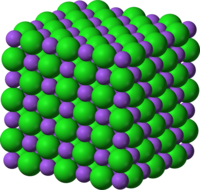
Photo from wikipedia
Hidden Rashba and Dresselhaus spin splittings in centrosymmetric crystals with subunits/sectors having non-centrosymmetric symmetries (the R-2 and D-2 effects) have been predicted theoretically and then observed experimentally, but the microscopic mechanism remains… Click to show full abstract
Hidden Rashba and Dresselhaus spin splittings in centrosymmetric crystals with subunits/sectors having non-centrosymmetric symmetries (the R-2 and D-2 effects) have been predicted theoretically and then observed experimentally, but the microscopic mechanism remains unclear. Here we demonstrate that the spin splitting in the R-2 effect is enforced by specific symmetries, such as non-symmorphic symmetry in the present example, which ensures that the pertinent spin wavefunctions segregate spatially on just one of the two inversion-partner sectors and thus avoid compensation. We further show that the effective Hamiltonian for the conventional Rashba (R-1) effect is also applicable for the R-2 effect, but applying a symmetry-breaking electric field to a R-2 compound produces a different spin-splitting pattern than applying a field to a trivial, non-R-2, centrosymmetric compound. This finding establishes a common fundamental source for the R-1 effect and the R-2 effect, both originating from local sector symmetries rather than from the global crystal symmetry per se.The Dresselhaus and Rashba effects have traditionally been expected only in non-centrosymmetric systems but recent work has shown that they can exist in some centrosymmetric materials. Here the authors show that the so-called hidden Rashba effect originates from wavefunction segregation enforced by local symmetries.
Journal Title: Nature Communications
Year Published: 2019
Link to full text (if available)
Share on Social Media: Sign Up to like & get
recommendations!